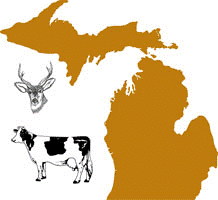Wildlife Disease and Zoonotics
Date of this Version
1999
Abstract
An epidemiological survey for the monitoring of bovine tuberculosis transmission was carried out in western Liguria, a region in northern Italy. Fifteen Mycobacterium bovis strains were isolated from 63 wild boar samples (62 from mandibular lymph nodes and 1 from a liver specimen). Sixteen mediastinal lymph nodes of 16 head of cattle were collected, and 15 Mycobacterium bovis strains were subsequently cultured. All M. bovisstrains isolated from cattle and wild boars were genotyped by spoligotyping and by restriction fragment length polymorphism (RFLP) analysis with the IS6110 and IS1081 probes. All M. bovis strains showed the typical spoligotype characterized by the absence of the 39 to 43 spacers in comparison with the number in M. tuberculosis. A total of nine different clusters were identified by spoligotyping. The largest cluster included 9 strains isolated from wild boars and 11 strains isolated from cattle, thus confirming the possibility of transmission between the two animal species. Fingerprinting by RFLP analysis with the IS6110 probe showed an identical single-band pattern for 29 of 30 strains analyzed, and only 1 strain presented a five-band pattern. The use of IS1081 as a second probe was useful for differentiation of M. bovis from M. bovis BCG but not for differentiation among M. bovis strains, which presented the same undifferentiated genomic profile. In relation to the epidemiological investigation, we hypothesized that the feeding in pastures contaminated by cattle discharges could represent the most probable route of transmission of M. bovis between the two animal species. In conclusion, our results confirmed the higher discriminatory power of spoligotyping in relation to that of RFLP analysis for the differentiation of M. bovis genomic profiles. Our data showed the presence of a common M. bovis genotype in both cattle and wild boars, confirming the possible interspecies transmission of M. bovis.



Comments
Published in JOURNAL OF CLINICAL MICROBIOLOGY, Sept. 1999, p. 2766–2771.